Today we travel to a future where the Earth’s magnetic poles reverse.
Guests:
- Eftyhia Zesta — Chief of the Geospace Physics Laboratory in the Heliophysics Division at NASA
- Michael Purucker — Planetary Magnetosphere Lab chief at NASA
- Alanna Mitchell — author of The Spinning Magnet
- Rory Cottrell — archaeomagnetism researcher at The University of Rochester
- Thorsten Ritz — biophysics researcher at UC Irvine
Further Reading:
- Earth’s Poles Will Eventually Flip, So What Then?
- The Magnetic Field Is Shifting. The Poles May Flip. This Could Get Bad.
- What drives 20th century polar motion?
- The Laschamp-Mono lake geomagnetic events and the extinction of Neanderthal: a causal link or a coincidence?
- Evidence for Geomagnetic Imprinting as a Homing Mechanism in Pacific Salmon
- Antiquity of the South Atlantic Anomaly and evidence for top-down control on the geodynamo
- A magnetic compass aids monarch butterfly migration
- Long-distance navigation and magnetoreception in migratory animals
- The Radical-Pair Mechanism of Magnetoreception
- Anthropogenic electromagnetic noise disrupts magnetic compass orientation in a migratory bird
- The Earth’s Magnetic Field and Visual Landmarks Steer Migratory Flight Behavior in the Nocturnal Australian Bogong Moth
- Magnetic Orientation in Animals
- The Future of the South Atlantic Anomaly and Implications for Radiation Damage in Space
- Ever-present South Atlantic Anomaly Damages Spacecraft
- Drift rate of the South Atlantic Anomaly
- The South Atlantic Anomaly throughout the solar cycle
- Cataclysmic Polarity Shift: Is U.S. National Security Prepared for the Next Geomagnetic Pole Reversal
- New Archeomagnetic Directional Records From Iron Age Southern Africa (ca. 425–1550 CE) and Implications for the South Atlantic Anomaly
- Antiquity of the South Atlantic Anomaly and evidence for top-down control on the geodynamo
- Does an anomaly in the Earth’s magnetic field portend a coming pole reversal?
Actors:
- The Snowglobe Narrator: Brent Rose
- Lenny Haywood: Evan Johnson
- Farah Mousterian: Zahra Noorbakhsh, host of Good Muslim, Bad Muslim
- John Jacob Siwa: Joseph Jones
- Juana Aguilar: Tamara Krinsky, host of Tomorrow’s World Today
- Roberta Peary: Avery Trufelman, host of Articles of Interest
- Ramona Byrd: Andrea Silenzi, host of The Longest Shortest Time
Flash Forward is produced by me, Rose Eveleth. The intro music is by Asura and the outtro music is by Hussalonia. The episode art is by Matt Lubchansky. Special thanks this episode to the Women Audio Mission studios, Maryam Qudus, Stephanie Lopez, The Potluck Podcast studio, the Potluck Podcast Collective and Quincy Surasmith.
If you want to suggest a future we should take on, send us a note on Twitter, Facebook or by email at info@flashforwardpod.com. We love hearing your ideas! And if you think you’ve spotted one of the little references I’ve hidden in the episode, email us there too. If you’re right, I’ll send you something cool.
And if you want to support the show, there are a few ways you can do that too! Head to www.flashforwardpod.com/support for more about how to give. But if that’s not in the cards for you, you can head to iTunes and leave us a nice review or just tell your friends about us. Those things really do help.
That’s all for this future, come back next time and we’ll travel to a new one.
FULL TRANSCRIPT BELOW
▹▹ ▹▹ ▹▹ ▹▹ ▹▹ ▹▹ ▹▹ ▹▹ ▹▹ ▹▹ ▹▹ ▹▹ ▹▹ ▹▹ ▹▹ ▹▹ ▹▹ ▹▹ ▹▹ ▹▹ ▹▹ ▹▹ ▹▹
Rose: Hello and welcome to Flash Forward! I’m Rose and I’m your host. Flash Forward is a podcast about the future. Every episode we take on a specific possible or … not so possible future scenario. This episode is number two, in our five part series all about the future of the EARTH. We always start the show with a little field trip to the future, to check out what’s going on, and then we teleport back to today to talk to real experts about how that future might… or might not unfold. Got it? Great! Today we’re starting in the year 2023. Oh, and if you listen all the way to the end of today’s episode… I have a very funny musical surprise for you.
Okay, let’s go to the future.
SNOWGLOBE INTRO
[music up]
Roberta Peary: Hello, my name is Roberta Peary and I’m an astrophysicist
Lenny: Wow
Ramona Byrd: And I’m Ramona Byrd, and I’m a luxury watch designer. And together, we’ve created
[in unison, awkwardly]
SUMERU
Roberta: Sumeru is a state of the art device that can give you localized information about the direction and strength of the geomagnetic field in your location.
Ramona: In non scientist speak, this is a beautiful object that can keep you and your family safe by telling you where the Earth’s magnetic field is stronger or weaker.
Roberta: All our current data suggests that we are in the midst of a polar shift — a time of great uncertainty during which the North and South poles of our planet change places. You of course, have noticed the effects of this shift — this filming location was selected based on the strength of the nearby electromagnetic field, and the bunker we’re in right now provides protection from radiation that could harm not just the cameras, but our bodies.
Ramona: But not everybody has access to a bunker, and to pick this filming location the executives at The Snowglobe probably had to work with scientists and satellites to figure out where the safest place was.
Roberta: That’s where SUMERU comes in. I’ve developed a completely new method of detecting the Earth’s geomagnetic field, without expensive equipment like satellites.
Ramona: And I’ve created a sleek, beautiful design to hold Roberta’s brilliant technology. SUMERU bands come in a variety of styles to match your personality, whether that’s ultramodern, active, young or hip.
John: Can we see those a little closer?
Ramona: Yes, of course, feel free to take one. [shuffling sounds]
John: These are nice! I really like weight on this.
Ramona: Thanks! Yeah, I’ve got about 15 years of experience designing name brand watches, so…
Juana: Does this tighten any more? I have small wrists.
Ramona: Oh yeah, here let me show you… [shuffling]
Juana: Ahhh okay I see, I see, great. Oh it’s cute!
Farah: Do you have a patent on this technology?
Roberta: I do, yes.
Farah: Great. Oh my god Lenny of course you picked the gold one, look at him!
[laughter]
Lenny: Listen, I know what I like!
John: So you sell these online? Or at a department store or what?
Ramona: We do about half of our sales online, and we’re currently in about 200 retail stores, mostly higher end boutiques and cute little shops.
Lenny: So how does this actually work? Like, how are you able to do this without satellites.
Roberta: Well… it’s sort of technical.
Farah: [annoyed] We’re not idiots.
Roberta: Okay, so the Earth’s magnetic field is largely determined by the activity in the crust right?
Lenny: Sure
Roberta: And in order to detect that activity you need multiple observation points. That’s why we largely rely on satellite data and huge computers, running complicated neural networks to paint a localized picture.
Farah: Okay
Roberta: But, we also know that animals can detect localized magnetic fields, somehow. And they don’t have access to satellites or deep neural networks or any of that. What they use is something called radical-pair reactions. Uh… this is the technical part. Radical-pair reactions are initiated by absorption of light through a photopigment and a subsequent electron transfer to a nearby acceptor molecule. After the electron transfer, donor and acceptor each have one unpaired electron, which possess a magnetic moment..
Lenny: Okay, yeah, stop. I have no idea what you’re talking about.
Roberta: Basically what I’ve done is figured out how birds can use chemical reactions to sense magnetic fields, and replicated that process in this device.
Farah: Okay, better! Better… that’s good enough. So inside this watch is a chemical reaction?
Ramona: Yes, exactly.
Farah: Does it ever run out?
Roberta: We don’t know
Ramona [cutting her off]: We haven’t ever had one stop working, and we’ve never been able to make the chemical reaction stop running in the lab.
Lenny: I mean can you guess? 10 years? 20 years?
Roberta: I’m a scientist, I don’t guess.
Ramona [quickly]: But, we have thought of that. And Roberta is working on a cartridge system, so that people can just reup the chemical reaction, and not have to buy a whole new watch.
Roberta: I’ve been wearing this prototype for five years and it hasn’t stopped working.
Farah: Okay five years, that’s not that bad.
Juana: I’m having a little trouble figuring out how you’d actually use this though… can you walk me through it? Like… I have this watch on and I am with my kids and I … use it to figure out where the safest route to school is?
Ramona: Yes, exactly so let’s say you’re going to leave your house, and you want to find the safest route to school, your SUMERU will help guide you in the direction with the strongest magnetic fields, and keep you most protected.
Juana: Okay but this is just like, an arrow, there’s no map. So how do I tell it where I need to get eventually.
Roberta: You don’t tell it exactly where you need to go, but you can see on the side there are these two little dials, you can set the width of how far you’re willing to stray from a direct path, and it will guide you within that.
Juana: But what if it tells me the safest path is through a building.
Ramona: I mean you could go around.
Lenny: I have an app that does this though. It shows me a map with hotspots. Why would I wear a watch that might ask me to walk through buildings?
Roberta: How often does that app crash?
Lenny: … okay you’ve got me there, it crashes a lot
Roberta: Exactly, a weak magnetic field means a lot of radiation which will wreak havoc with your cell phone’s ability to communicate with any kind of network. And it’s only going to get worse.
Juana: I don’t want something that’s going to lead me through random alleys — I’m usually running late to take my kid to school and a tiny more magnetic field doesn’t seem worth it to wind up on some wild goose chase following this arrow thing. I’m out.
John: What do you mean it’s only going to get worse.
Ramona: [uneasy laugh] Oh, Roberta can be a bit of a tin foil hat person sometimes.
Roberta: [annoyed] As the Earth’s magnetic field weakens radiation from space will most likely wipe out our entire power grid. If it gets really low, going outside could cause serious health problems, since radiation mutates our cells and causes cancer. Right now, this watch can help you feel a little safer, but when things start to get worse, this watch could help you stay alive.
Lenny: Oh boy, okay, I think you’re crazy, and for that reason, I’m out.
John: If things get that bad are people really going to spend … what $45 on a watch? Can they even order online if the entire power grid is out?
Farah: What are you asking for from us.
Ramona: We’re looking for 300,000 for 10% of the company.
Farah: So what I’m seeing here is a company that’s trying to capitalize on looming disaster, right? We know that the poles are reversing, but right now it’s not THAT bad. You’re trying to capture a market in this tiny sliver of time, once it becomes clear that things are going to get worse, but before they get so bad people can’t order your product at all.
Ramona: No I think this product is totally marketable right now. We hear from parents all the time who want to keep their kids and families as safe as they can.
Farah: Right but if you really want this to be something every person owns, like a watch, you can’t just be selling to the most paranoid moms.
Roberta: It’s not paranoia it’s science.
Farah: I have some ideas for you, on how to market this at the exact right moment before everything goes to hell. Because, unlike Lenny, I actually don’t think you’re crazy, Roberta. I think you’re right. The question is whether or not you two know how to capitalize on panic or not. And I don’t think you do… but I do. And I think I could make us all a lot of money. But I’m going to need more than 10%.
Ramona: We could do 15%
Farah: Not worth it to me. How about this. $300,000 for 15% and I want $10 on every unit sold. Because what I think is going to happen here is that you’re going to sell well for a while, and then if we play our cards right we sell REALLY well for a year before everything collapses. And I use that money to build my protective bunker in the middle of the ocean.
Ramona: … can we take a minute to talk about it?
Farah: No more than a minute
Roberta: [whispering but less quietly] she’s right about the sales plan, I told you that was what we should have pitched
Ramona: not the time, should we take her deal
Roberta: counter with $7/sale and then say yes to whatever she responds with.
Ramona: We’ll take the deal for $7 a unit, not $10.
Farah: No deal, $10 or nothing.
[awkward silence]
Roberta: We accept.
Farah: Excellent! We’re going to make some money before society collapses girls!
[music up]
Rose: Okay, so today’s episode is about what happens when the Earth’s magnetic fields, reverse. But before we can get into how and why that might happen, we need to go over a bit of high school planetary science. Why does the Earth have a magnetic field to begin with?
Eftyhia Zesta: The fundamental is that we have a planet that is rotating. It has a solid core. Around the solid core there is molten material that is magnetic.
Rose: This is Eftyhia Zesta, a researcher at the Geospace Physics Laboratory at NASA. So the Earth has lots of layers right? In the very middle there’s the inner core, that’s about ⅔ the size of the moon. This inner core is EXTREMELY HOT, 5,700 degrees Fahrenheit, which is as hot as the surface of the sun. And because that inner core is under so much pressure, it’s solid. Around this solid inner core, is the outer core, which is also very hot but under a little less pressure, so it’s liquid. And, crucially, both the inner and the outer core are made up of metals like iron, that are magnetic, like iron.
Eftyhia: When you get anything that is magnetic that keeps moving, it creates huge currents and those currents that are essentially like a dipole magnetic field.
Rose: A dipole magnetic field just means that the field moves in a loop, always going from one end to another. So in Earth’s case you have a North Pole and a South Pole, and the current moves from one of those poles to the other.
Eftyhia: So, because you have this rotating liquid amount around the solid core, you have large magnetic fields.
Rose: If you want to kind of break your brain for a second — which happened to me many times in working on this episode — here’s a fun fact. When humans talk about the Earth, we all kind of consider the same North and South, right? The North Pole, where Santa lives, is the Arctic and the South Pole, where the penguins are, is Antarctica. But technically, in physics, when you have a dipole, the magnetic field always moves from North to South. But on Earth, if you look at the magnetic field lines, our field is flowing from what we call the South pole to what we call the North pole. So technically, today’s north is actually south. In magnetism terms.
Anyway, the key thing to know is that the Earth has a magnetic field.
Michael Purucker: And that is unlike the situation on the other planets, most of the other planets in the solar system, and the moons
Rose: This is Michael Purucker, a researcher at the Planetary Magnetosphere Lab at NASA. And he’s studied the magnetic fields of a bunch of the planets in the solar system. Mars, for example, used to have a magnetic field, but it doesn’t anymore.
Michael: And that probably died out, 3.5 billion years ago, maybe even later. The same is true at the moon, the moon does not now have a global magnetic field of its own; it has some remnant magnetic fields, like Mars. I personally think that the most interested in magnetic field in the solar system belongs to Uranus.
Rose: Uranus has this super weird magnetic field because it’s tilted on its side, so basically its magnetic field is at a 90 degree angle to the way the planet rotates, which is weird. Anyway, the key thing here is that Earth is kind of special, because Earth has a global magnetic field that is juuuust right. It’s not too weak, it’s not too strong, it’s not too small, it’s not too big, it’s the perfect magnetic field. Well, for us. I’m sure Uranus thinks that it has the perfect magnetic field for its purposes. But having a very particular kind of magnetic field is really crucial to the existence of life on Earth. And that’s because the magnetic field is one of the things protects us from all the dangerous stuff out in space.
Alanna: People think about outer space as a sort of big empty thing, but it’s not at all. It’s incredibly dangerous, incredibly volatile. It’s full of radiation. It’s full of charged particles. It’s full of bits of the electromagnetic field that are highly damaging to life. And this magnetic field that surrounds our planet is one element of our protection from all of that
Rose: This is Alanna Mitchell, the author of a book called The Spinning Magnet, all about the Earth’s magnetic field.
Alanna: It’s really sort of a cocoon around the planet.
Rose: Of course, early scientists had no clue how important this cocoon was — they didn’t know anything about radiation from space, or charged particles, or any of that. In fact, for a long time scientists weren’t even sure if the Earth’s magnetic field was innate to the Earth, and was constant, or was something that just showed up sometimes.
Alanna: People back in – before 1600 certainly – thought that it was almost like a magical thing, it came and it went and you couldn’t really on it. Around 1600, when William Gilbert wrote his first treatise on magnetism, he realised that it was a permanent function of the planet. And so he started calling it the Earth’s magnetic soul.
Rose: It’s hard to say exactly when humans figured out that the Earth had this magnetic soul. It was probably discovered independently in various parts of the world, as people started experimenting with magnets and navigational tools. Over time, scientists around the world started gathering data and painting a picture of what this magnetic field looked like and publishing treatises on magnetism. And then, something … very strange happened.
Alanna: Okay, so this is the beginning of the 20th century, so 1900 or so.
Rose: There’s this guy named Bernard Brunhes.
Alanna: He is living in almost the dead smack centre of France, in the volcanic heart of France.
Rose: Brunhes gets this job as the head of an observatory. So he’s mostly supposed to be taking weather condition data.
Alanna: But he became interested in magnetism, the Earth’s magnetism, because it was a big hot topic at that time, and there was a whole lot of research.
Rose: Don’t you wish we lived in a time when the hot topics in science were things like “the Earth’s magnetic field” and not “how soon will climate change kill us all?” Anyway… Brunhes decides that his contribution to this hot topic lies in a very specific kind of rock.
Alanna: It’s a layer, a seam of terra cotta – so that’s a sedimentary stone – that had been laid down millions of years before. And then, at some time after that, there was a volcano that covered it, covered the seam of terra cotta with hot lava.
Rose: So Brunhes literally puts out a call to people being like “hey my friends, I’m looking for this rock, can you help me find it?” And this road maker gets in touch and is like, “my dude, I found your rocks.”
Alanna: This thing that you’re looking for, I found it. I just caught a road. It’s down at a little place called Pontfarin, which was basically a day’s donkey ride or horse ride from where Bernard Brunhes lived at that time. And and so Bernard Brunhes literally got on his steed, and packed his chisels and went down to this new road cut.
Rose: So he rides down to this new road, collects his rocks, and brings them back to the lab. And he needed this really particular, really rare type of rock for a reason. Brune suspected that the way that this rock was formed, would tell him something about the Earth’s magnetic field. And here’s why… remember that the rock has to start with terra cotta.
Alanna: Terra cotta happens to be an unusual type of rock, it has a lot of iron in it.
Rose: And iron, as you know, has magnetic properties. So when terra cotta is first formed, the iron molecules in the rock actually record the direction of the Earth’s magnetic field. And there’s only one thing that can really change that record — extreme heat. Which is where the lava comes in. So, if lava flows over the terra cotta and heats it up really hot, the iron molecules get excited again, and shake off that original compass reading. When the lava and terra cotta cool again, those iron molecules reset, to whatever the magnetic field was at the time of the lava flow.
Alanna: These iron molecules within the terra cotta were like a fossilised compass.
Rose: And when he looked at this fossilized compass, Brunhes found something totally bizarre.
Alanna: The poles were on opposite sides of the planet.
Rose: In other words, according to Brunehes’ data, at some point in the Earth’s history, the poles had switched. North was South and South was North. And when he published these findings, people freaked out.
Alanna: And he was ridiculed. I mean, this was a scandal, in scientific terms. I mean, nobody could figure this out. It was absolute anarchy in the scientific world. They didn’t have a clue what was going on.
Rose [on the phone]: Did Brunhes… when he went out there, he knew he was looking for this very specific rock, did he expect to find a reversal, or did he just expect to find something interesting?
Alanna: He didn’t expect to find a reversal, he was gobsmacked to find this. There was nothing in any of that theory about the Earth’s magnetic field that suggested that those poles were capable of switching places. He was just trying to get a few more data points for the history, the story of the Earth’s magnetic field. He had no idea that he was about to change the whole narrative.
Rose: Unfortunately, Brunhes didn’t live to see that narrative change. He actually died just a couple of years later, and it took fifty years before the idea of polar reversals became accepted. In fact, Brunhes has been largely forgotten in scientific history. But one of the former directors of the observatory that Brunhes used to work at, is on this crusade to try and get him his proper credit.
Alanna: He took me to the road cut, which still exists. It’s the same road cut, it hasn’t been expanded. There’s no marker there, you have to do some detective work even to get there. You know, we drove for, I’m going to stay, an hour and a half along these little tiny roads. You know, “is it here? is it here? is it here?” Trying to figure out exactly where this piece of terra cotta was that changed the course of science. And it’s still there. It’s all overgrown. You climb up on the bank, and there’s all this moss, and all these weeds, and these little scraggly trees, and all these empty wine bottles you know the people tossed off. And that’s that is the site of one of the great discoveries in scientific history.
Rose: Today we know that the poles have moved around not just once, but a lot through the Earth’s history. There’s actually a whole field of research called Archaeomagnetic dating — where scientists try and chronicle the timeline of the Earth’s magnetic field.
Roray Cottrell: We have collected basalts from many places, including the high Canadian Arctic. Lavas that were erupted in the north west Pacific Basin. We’ve collected lavas in India, and Africa, and Australia, and a bunch of other places.
Rose: This is Rory Cottrell, a researcher at the University of Rochester. Rory works on trying to better understand the geomagnetic history of the Earth. Scientists know that the last full polar reversal happened 780,000 years ago. But younger rocks and samples can also tell us about the oddities of the Earth’s magnetic field, even when it’s not switching places. And one of the oddities that scientists are really interested in right now, is called the South Atlantic Anomaly.
So, visualize the Earth. Now visualize magnetic field lines coming out of the south pole, and wrapping around the earth and going into the North Pole. You’ve got that picture in your head? In an idea world, all these lines are totally normal, moving along in a nice even bendy path from South to North. In reality, though, things are a lot weirder looking.
Rory: What’s happening around the area of the South Atlantic Anomaly is those field lines are going the wrong way. You have a smaller magnitude.
Rose: A smaller magnitude means a weaker magnetic field, which is what you find in the South Atlantic Anomaly, which spans for about 120 miles, and covers a good chunk of the Southern part of South America, and out to the East into the ocean to South Africa. And that weaker field means less protection from radiation, which means that satellites and airplanes that travel in that region have to be careful. There are plenty of documented cases where satellites that move through the South Atlantic anomaly lose power, or go offline, or get damaged in some way. When the Space Shuttle flies through the anomaly, laptops on board sometimes crash.
Eftyhia: All the pilots the fly airplanes over South America, they’re all very aware of the South Atlantic Anomaly. They have to properly account for it when they fly over it. They have to properly account for radiation dosage.
Rose: Right now, the South Atlantic Anomaly is growing, but it’s hard to tell if that’s normal or not. We don’t know if it grows sometimes and shrinks other times, or what. So one of the things Rory does is try and understand how this South Atlantic Anomaly has changed over time. And to do that, Rory does basically what Brunhes did, look for rocks that record the state of the magnetic field in a place. But remember, these rock formations, they’re rare. But it turns out there’s another kind of sample you can use to do this.
Rory: Lava’s not the only thing that can record the Earth’s magnetic field. So can pottery.
Rose: Okay this is so cool. Basically, the firing process of pottery is kind of like the lava, it heats the clay up to a high enough temperature that the magnetite or iron in the clay actually resets and records the magnetic field at the time of firing. So if you look at pottery from archaeological sites, you can see what the magnetic field was like when that pottery was made.
Rory: But it’s not just pottery, we can also look at any material that has been fired, or set on fire as the case may be. There are a number of archaeological sites throughout southern Africa that have hosted villages that for some reason – maybe a drought, maybe something has killed the animals in the area or something bad has happened – there would be a ritualistic cleansing of the village. Basically, they set everything on fire. And as a result the hut floors, the grain bins, the cattle pens, everything that was part of this village is set ablaze and these temperatures will be above that of the Curie temperature of magnetite.
Rose: The Curie temperature is the temperature at which the magnetic record in a material will reset, basically.
Rory: So having an archaeological context, usually based on pottery and the different ornamentations of pottery, as well as using carbon-14 dating, we know when this firing occurred, reasonably well. And we have these fired objects that we can then sample to obtain information about the Earth’s magnetic field.
Rose: Rory has looked at samples from these archaeological sites that date all the way back to the Iron Age. And this is not just very, very cool, which it is… but it could also help people better identify a future geomagnetic reversal. In fact, some people think that the South Atlantic Anomaly is the key to predicting the future of our magnetic field.
Rory: Does the decreasing strength of the Earth’s magnetic field mean that magnetic field is collapsing? Or could it be heading towards a reversal state? That’s one of the things that we want to know. Because humans haven’t been around and studying the Earth’s magnetic field since the last reversal.
Rose: And when we come back we’re going to talk about why some people think that we might be living through the beginnings of a geomagnetic shift, and what might happen if we really are about to enter into a period of polar reversal. But first, a quick word from our sponsors.
[[AD BREAK]]
Rose: Okay, so we’ve covered the history of the poles, let’s talk about the poles today. On February 4th of this year, researchers released the new World Magnetic Model, which is basically the globally agreed upon model of what the magnetic field looks like. This is the model that everybody from the Department of Defense to NATO to pretty much every civilian navigation system uses to make their maps accurate. The last World Magnetic Model came out in 2015, and it was supposed to last until 2020 – these models always come out every five years. But the North pole had other plans. Right now, the North pole of the Earth is moving away from Canada and towards Siberia way faster than anybody predicted. And that movement was really messing with the model. Early last year researchers reported that the model was quote “so inaccurate that it was about to exceed the acceptable limit for navigational errors.”
And in the South Atlantic Anomaly, things are weird too. The field is currently getting weaker. And some people point to that weakening field in places like southern Africa as a sign that we might be entering into a reversal. But not everybody agrees. Rory’s work has found that this has actually happened in the past. For example, between 1250 CE and 1000 CE the strength of the magnetic field in that region was decreasing twice as fast as it is now. So we might not be seeing a polar flip, but rather just normal, random variation in the strength of the field.
So all of this could be totally normal change, or it could be the beginning of a polar reversal, and there seems to be no real way for us to know which one it is. In fact I asked everybody that I interviewed for this episode how we would know, if we were experiencing the beginnings of this, and they all basically said… we wouldn’t. There’s no agreed upon set of things, no checklist, that indicate that yes, in fact, this is happening.
One of the reasons it’s hard to know, is that not all polar reversal seem to happen the same way. They don’t always take the same amount of time, or unfold in the exact same order. But we do know that during the reversal, the magnetic field gets really weird.
Alanna: this is the most fascinating thing of all. Within the core itself, in fact, there are all these magnetic factions that are there. I think of them as rivals. You know, the battle of the Titans.
Rose: When everything is normal, these battles kind of average out into a dipole system, a North and South pole. But when you look closely, you see that there are always lots of little fields bubbling up here and there, fighting for dominance.
Alanna: And every now and again they win, and when they win, this dominant two pole system is toppled.
Rose: It’s like Game of Thrones but deep inside the Earth.
Alanna: So, on the surface, instead of having two poles, we will have four, or six, or eight poles as the dipole moves and has to change direction in order to re-establish its dominance over the Earth’s magnetic field.
Rose: And during all this fighting, where these other factions rise and take control of their little area of field, the overall global magnetic field gets weaker.
Alanna: The shield that protects us from galactic radiation becomes only about a tenth of its usual strength.
Rose: And then, eventually, as you reach the finale of this big war, the new winners emerge
Alanna: The poles change places, the field reverses its direction and everything snaps back into place and the dipole becomes dominant again. And these other little factions go back to having little skirmishes, as opposed to having these great huge winnable wars.
Rose: The good news here is that this war will be long. Very long. It’s not like we’re going to wake up one morning and North will be South and South will be North and chaos will reign.
Eftyhia: It’s going to take a much longer time. It’s going to take multiple generations, or thousands of years.
Rose: But, let’s say we are on the cusp of a flip. Which, again, we don’t know if we are, and even if we were none of us would live to see the results. Still! This is a show about speculation! Let’s get to speculating! What happens next?
Well, humans have never lived through a polar reversal, the last one happened 780,000 years ago and homo sapiens didn’t really emerge until 350,000 years ago. But plenty of non-human animal species have survived these reversals, which got me wondering how this might impact all of the creatures that rely on the magnetic field of the Earth to navigate.
Thorsten Ritz: In birds, it’s not just migratory birds where this has been discovered. Certainly pigeons, even chickens seem to have a magnetic compass. And then there’s fish. There are reptiles.
Rose: This is Thorsten Ritz, a biophysics researcher at UC Irvine,
Thorsten: There’s even a few mammals where this has been discovered. One of them is a blind mole rat that burrows. And they seem to built their nests always towards the south. Insects certainly, the monarch butterfly. There’s a whole range of different animals.
Rose: One of the things that Thorsten has spent years trying to figure out is how animals detect magnetic fields. Here’s something I didn’t know until researching this episode: Scientists have had conclusive proof that animals can detect the magnetic field of the Earth, and use it for navigation, since the 1960’s. But it’s actually still kind of a mystery as to how they actually do this.
Thorsten: They are a limited number of ideas of how this might work, because it’s actually… we have to understand it’s a very weak field. We think about the the Earth’s magnetic field as some giant fields. But if you look at the strength of it, if you have a little fridge magnet that you put there to hang up some pape. the magnetic field of the Earth is about 10 times weaker when you measure it than what you would measure close to such a magnet. So, it’s a very weak field.
Rose: Because the field is so weak, whatever it is that animals are using to detect it has to be really sensitive. Scientists think that some animals are actually using electric sensors.
Thorsten: And there’s some fish The Elasmobranch fish, which are sharks and other animals like that, have a very good electric sensors. And they may very well use this to detect magnetic fields as well.
Rose: Researchers have identified these structures in fish, they have a really cool name they’re called Ampullae of Lorenzini, and you can actually see these little pores on some animals, like tiger sharks. But there’s a problem with this idea when it comes to birds or mammals.
Thorsten: There is just no evidence that any structure like that exists in a land based animal.
Rose: So when it comes to land animals, there are two main theories. One is that animals have a small amount of magnetite in certain cells that act like little compass needles.
Thorsten: And there’s actually one type of organism that uses that and these are these magnetic bacteria.
Rose: These bacteria use their tiny magnets to tell up from down in their little ponds. So perhaps, the theory goes, birds or mammals have somehow incorporated these tiny bacteria into their bodies in some kind of symbiotic way, to borrow their magnetic field detection abilities.
Thorsten: But it has proven to be fairly difficult to actually find, conclusively, something that is a structure that is a candidate structure.
Rose: What Thorsten works on is another possible explanation for this magnetic sensing ability, and it’s an idea called the radical pair mechanism. And this is where we get into quantum physics! Woo! This is how the device you heard about in the little fictional intro works, by the way. All that science Roberta was saying is, in fact, real. So… buckle up, we’re going to talk about quantum physics! Let’s start with electrons.
Torsten: If you go down to electrons, you can think of them like little compass needles. They have a magnetic moment, because of the quantum mechanic property that is called spin.
Rose: Here are the two things you need to know about electrons to understand how this works: First, electrons really prefer to exist in pairs. And second, each electron has a quantum property that’s called spin, which is actually created by the magnetic field of the Earth. And when electrons are in their happy state, in pairs, they always spin in opposite directions. So it’s like, that couple that is attached at the hip at every party but also seem like, completely different people, and you have no idea how they are even dating?
Thorsten: That’s how the electrons are happy, and that’s a steady state. But you can, if you put in a lot of energy, separate these electrons. And then you have two electrons that are unpaired, and those are called radicals. Not because they’re radical in a political sense, but because they’re at the root – which the Latin word is radix for root – at the root of chemical reactions.
Rose: So if you break this happy electron couple up, you get some weird effects. While an electrons is waiting to re-pair, it’s kind of in limbo; it’s knocked out of its normal spin state. Remember, in any paired set of electrons they really prefer to have opposite spins. So when you reshuffle, your lonely mopey electrons need to make sure they are spinning in opposite directions from their new partner, otherwise this new relationship just isn’t going to work.
And here is where we get to the magnetic field — remember that the magnetic field is what creates spin. So when those electrons partner back up, and start spinning again, the magnetic field affects their new spin states.
Thorsten: And that will give rise to, essentially, different chemistry.
Rose: That different chemistry can, in theory, then be picked up by an animal’s brain and interpreted as a signal that tells them something about the magnetic field of the Earth.
Thorsten: And there’s also some studies that show that there is a brain area that’s linked to the eye that that’s active during magnetic orientation. And if you lesion that center, then the birds are not capable to use a magnetic compass anymore, even though they can still orient to the sun compass, and the star compass.
Rose: But this is all still kind of a theory, there’s no conclusive evidence that this is actually how animals like migratory birds are detecting magnetic fields. And since we don’t know exactly how they sense the Earth’s field, it makes it harder to say what might happen if the poles reversed. Researchers do know that most animals don’t rely on just one signal when it comes to where they should go during a migration.
Thorsten: The magnetic compass doesn’t prevent you flying into a building. So you need visual cues as well.
Rose: But, and here’s the very cool part, birds don’t think about magnetic directions the way we do. So when we talk about a compass, we’re really mainly measuring the horizontal direction of the magnetic field. But Earth’s magnetic field has a vertical component too. So remember when you were picturing the Earth’s magnetic fields, with lines all coming out of the South pole and going around to the North pole? Those lines are bendy right? They kind of come out at a sharp angle, even out over the middle of the Earth, and then rejoin at a sharp angle at the North pole, right? Our compasses only really measure the horizontal element of those lines.
Thorsten: And if you reverse the magnetic fields, obviously the compass needle points in the opposite direction.
Rose: But if you measure using vertical components, switching North and South doesn’t change anything.
And this is how birds seem to process magnetic fields.
Thorsten: It seems to be that maybe birds have a genetic program that doesn’t so much distinguish north from south, but pole-ward versus the equator-ward. So, essentially, at the equator the magnetic field lines are flat with the horizon. Whereas at the poles, they are steeper. And so if you have a genetic program that tells you to go to where the magnetic field gets steeper, you’re flying towards the poles. And that works regardless of whether the magnetic field has flipped around or not.
Rose: Which means that once the poles are fully flipped, birds and other animals that navigate using magnetic fields, will probably be fine.
Thorsten: And so it seems like maybe because the magnetic field is flipping on a fairly regular basis, that animals have evolved in a way to not only rely on the magnetic fields, and that’s already factored in to a certain extent.
Rose: Isn’t that so cool!? Now, this isn’t to say there won’t be challenges for animals when they’re trying to navigate, especially during that long stretch of time where the poles are fighting for dominance.
But on the whole, the flip won’t mean entire species of birds wind up dying out because they can’t figure out how to get home or how to find their breeding grounds. And this lines up with the fact that so far, there’s zero evidence linking pole reversals with mass extinctions. In fact, the species that will likely have the hardest time with a pole reversal… is us. Humans I mean, sorry to assume there are no animal or non human entities listening to this. Very rude.
Anyway, when we come back, we’ll talk about why living during a polar reversal might actually be really, chaotic for the human species. But first, a quick word from another one of our sponsors.
[[AD BREAK]]
Rose: So, if you google pole reversal, you get a lot of stuff that basically says that this would destroy humanity. It’s actually a plot in a pretty bad Marvel comic called Ultimatum in which Magneto steals Thor’s hammer and uses it, along with his magnetic powers, to reverse the Earth’s poles which leads to tsunamis and storms that completely destroy a bunch of cities. And if you’ve seen the very bad movie The Core, they do a little demonstration for what happens when the Earth’s magnetic field dwindles.
Rory: And I show this in one of my classes:
THE CORE:
Dr. Zimsky: The earth’s EM field shields us from the solar winds, which are a lethal blend of radioactive particles and microwaves. When that shield collapses, microwave radiation will literally cook our planet.
Rory: The demonstration that they did before Congress and the military was they stuck a fork in a peach and then made that, basically, represent the Earth
THE CORE:
Dr. Keyes: This is the earth, without the EM field.
Rory: And they basically used an aerosol can and lit it on fire and basically burned the peach to bits
THE CORE:
Dr. Zimsky: Three months, gentlemen, and we’re back in the Stone Age. A full year, the field collapses… and that.
Rory: That is, in essence, a dramatic but cogent version of what can happen to the earth’s surface in the absence of a magnetic field.
THE CORE:
Dr. Keyes: Feel free to throw up. I know I did.
Rory: The Earth’s magnetic field protects the atmosphere. And it’s the atmosphere which is an important temperature regulator for the planet. Without a magnetic field we would have an average surface temperature of about minus 18 degrees Celsius. That’s kind of cold.
Rose: Minus 18 Celsius is minus 64.4 degrees Fahrenheit.
Rory: As an example, Mars no longer has a magnetic field and it’s surface temperature is quite cold. So without a magnetic field in place solar radiation can strip away the atmosphere. You strip away the atmosphere, and you take away one reservoir of water, and you allow the surface reservoir of water to also go away. So without a magnetic field, basically we have no water, to put it real simple.
Rose: Here’s a fun little callback: remember the episode we did about what it would take to destroy all life on the planet? If not, it’s an episode called After Life and you can check it out after this one, but basically we talked to two scientists who tried to figure out what it would take to completely wipe the Earth clean of all life. And they decided that to do it, you’d have to boil the oceans. And their conclusion was that it would be really, really hard and unlikely for the Earth to be hit with enough energy for this to happen. But they did not consider the possibility that Earth might not need to be hit with any energy at all — if we lose our magnetic field, we will lose our oceans, too.
Losing our magnetic field is unlikely. So, even if it doesn’t get that weak, depending on what those warring magnetic field factions wind up looking like during the reversal, some parts of the planet could get kind of dicey.
Alanna: When I talked to people who are worried about galactic radiation, and who track galactic creation, and what will happen to the planet when there’s a smaller magnetic shield around our planet, they tend to be a little bit more worried. They tend to think that there will be more access to life. There will be more really radioactive access to the surface.
Rose: The more access that this radiation has to us, the worse it will be.
Alanna: I mean, one of the scientists I talked to said that he thought parts of the Earth will become uninhabitable. And he couldn’t predict which ones.
Rose: Scientists also know that the ozone layer will likely be impacted by a weakened magnetic field.
But, despite the very factual journalistic outlets like Marvel Comics and The Core claiming that this future is possible, I will say, that most experts are not actively worried about pole reversals wiping out out all of humanity. In fact, when I asked Michael and Eftyhia about it, they laughed at me.
Eftyhia: You telling me that people are actually afraid of this, and bringing doom and gloom is the first that I have heard of it.
Michae: Yeah. It’s not something we…
Eftyhia: …didn’t even conceive of it.
Rose: In my defense, there are lots of people who have written about the potential for a polar reversal to do real damage to things like infrastructure, including the US military, who published a report called “CATACLYSMIC POLARITY SHIFT: IS U.S. NATIONAL SECURITY PREPARED FOR THE NEXT GEOMAGNETIC POLE REVERSAL?” The report concludes that “the nation is not prepared for both geomagnetic polarity reversals and adverse space weather.”
Here’s why some people are actually a little bit worried. We know that a weaker magnetic field means less protection from space weather. And we know that space weather can impact power grids. The most famous, and extreme example of this is what’s called the Carrington Event, which happened in 1859. During a big solar storm, the Earth was blasted with a ray of plasma from the sun, which caused blackouts, took down telegraph lines, and caused what telegraph operators described as “streams of fire” to pour from the circuits.
Alanna: The only technology we had was telegraphs, and the telegraph system became this great conductor for electromagnetic energy. And so, parts of it burst into flame, parts were just simply scorched. It was the first globalized electronic technology, and it was pooched. Just flat out pooched.
Rose: Today, our electrical infrastructure is far more developed. In 2012, the Earth had a near miss on a similar solar storm. And experts who analyzed that event said that if it had actually hit Earth, the results would have been catastrophic.
Alanna: We would have been thrust back into Victorian ages. And it would’ve lasted for decades; this damage to the electric grid system.
Rose: Obviously this kind of solar storm is dangerous even when the poles are not reversing. But remember this polar reversal can take thousands of years. And if a similar solar weather event were to hit the Earth while the magnetic field was weakened during a polar reversal, the impact would be even worse.
Alanna: What happens when the Earth’s magnetic field is only 10 percent of its usual strength and you have a solar storm? Or you have another attack of galactic radiation?
Rose: Then there are the people who worry about satellites and what a wonky magnetic field might do to them. Remember how the South Atlantic Anomaly already messes up satellites and systems in space? Well that would only be more true in a world of a geomagnetic reversal. And today’s systems on the ground, that you and I use all the time, rely more and more on satellites for things like GPS and communications.
Of course, these are hypotheticals. We don’t know when the next reversal will happen, and Eftyhia says that one reason she doesn’t worry is that this will happen slowly, and she thinks humans will have time to adapt the grid and update the technology as needed.
Eftyhia: I don’t think it will have any impact. We will just slowly learn.
Rose: In fact, Eftyhia thinks that in this future, where we’ve slowly updated the electrical grid to be protected from whatever the impact that our weaker magnetic field might have, will also be better protected against Carrington like events.
Eftyhia: You know, Katrinas happen, and the Carrington Event could happen again, but in a society 2,000 years ahead, or 3,000, or 10,000 years, where the magnetic field is in the process of reversing, they will respectively – if they are a space faring society – they will again prepare for that condition and they will build their satellites for those conditions. Do you see what I’m trying to say?
Rose [on the phone]: Yeah, I think you have more faith in the updates to the electrical grid than the military does, is what I’m saying.
Eftyhia: [Laughter]
Rose [on the phone]: They’re worried that we aren’t going to update because our electrical grid is already outdated and isn’t protected in many ways, right? I think that’s what people are worried about.
Rose: So, as much as I love end of the world scenarios, I will say that if you’re going to stay up late at night worrying about something, this probably is not the thing to pick. Even if we are at the dawn of a new geomagnetic reversal, we’ll all probably die without even knowing it. The switch will take thousands of years, and the impact on each individual human generation will likely be small. But you don’t just have to take my word for it: nobody I talked to for this episode really truly worries about this.
Alanna: It’s not one of these things that keeps me up at night, if you know what I mean. It’s probably a long time in the future and it’s unclear exactly what will happen.
Eftyhia: No.
Michael: I worry about a lot of other things.
Eftyhia: I worry about a lot of other things, but that particular thing does not keep me up at night. No.
Rory: My cats keep me up at night. Not the magnetic field. Will it reverse in our lifetime? Probably not, but kind cool if it did. We could see what happens.
Rose: I’m sure you can find plenty of other things in the Flash Forward catalogue to fuel your nightmares.
[music up]
That’s all for this episode…. CREDITS
Flash Forward is produced by me, Rose Eveleth. The intro music is by Asura and the outro music is by Hussalonia. The episode art is by Matt Lubchansky. Special thanks this episode to the Women Audio Mission studios, Maryam Qudus, Stephanie Lopez, The Potluck Podcast studio and the Potluck Podcast Collective and Quincy Surasmith.
The narrator for The Snowglobe is played by Brent Rose. Lenny Haywood is played by Evan Johnson. Farah Mousterian is played by Zahra Noorbakhsh, who hosts a podcast called Good Muslim Bad Muslim, definitely go listen to that. John Jacob Siwa is played by Joseph Jones. Juana Aguilar is played by Tamara Krinsky, who is the host of Tomorrow’s World Today, now streaming on Amazon. Ramona is played by Andrea Silenzi, who hosts a podcast called The Longest Shortest Time a show about parenting that even I, a non parent, really enjoy. Roberta is played by Avery Trufelman, a producer at 99 Percent Invisible and the host of a mini series called Articles of Interest which is all about what we wear, and how it came to be.
You can find more about all those actors, and our guests this episode, in the show notes. And you can find further reading materials at FlashForwardpod.com.
If you want to chat with other listeners about this episode, or about the future in general, join the Flash Forward Facebook group. You can find that by searching for Flash Forward Podcast on FB, it’s a closed group but I will add you as long as you’re not very obviously a bot account! If you want to suggest a future we should take on, send us a note on Twitter, Facebook or by email at info@flashforwardpod.com. I love hearing your ideas! And if you think you’ve spotted one of the little references that I’ve hidden in the episode, email us there too. If you’re right, I’ll send you something cool. A hint on the references, because lots of people have asked me: 1) Listen to the advertisements. I sometimes put them in there. 2) Pay attention to the names of the various characters in the different sketches at the top. Those are often where the references are found. Okay, I’ve said too much already.
And if you want to support the show, there are a few ways you can do that too! Head to www.flashforwardpod.com/support for more about how to give. But if that’s not in the cards for you, you can head to Apple Podcasts and leave us a nice review or just tell your friends about the show. Those things really do help.
And now… for the surprise! I was recently a guest on the very funny, very charming, very impressive podcast Song Salad. On every episode of Song Salad the two hosts, Shannon & Scott write an entire song about something in just 45 minutes! At the beginning of every episode they spin the salad spinner of fate, which determines the genre of the song they have to make, and they click “Random Article” on Wikipedia to get a topic. But this week, they let me pick the topic! And I picked geoengineering, obviously, since that’s what last week’s episode of Flash Forward was about and I’ve been thinking about it non stop. And oh my god … people… the song they made has been stuck in my head since they played it for me. You can listen to the whole episode of Song Salad wherever you get your podcasts, and you absolutely should. The episode includes an interview with me, but more importantly a really funny behind the scenes look at what goes into writing these songs. And Shannon and Scott very graciously said it was okay for me to play the end result for you all on Flash Forward. So, without any further ado, here is a song about solar radiation management, in the style, of electrofunk, by Shannon and Scott.
SONG
Okay, that’s all for this future. Come back next time, and we’ll travel to a new one!
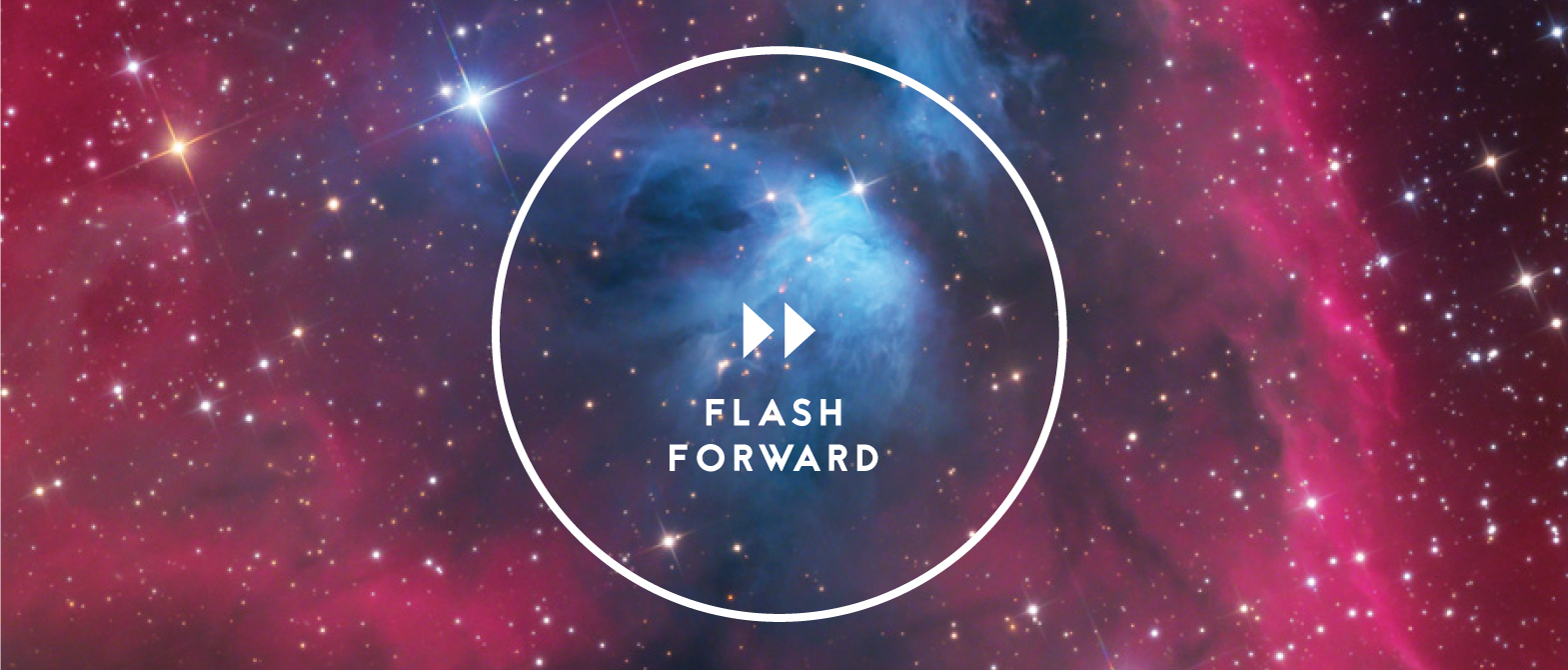
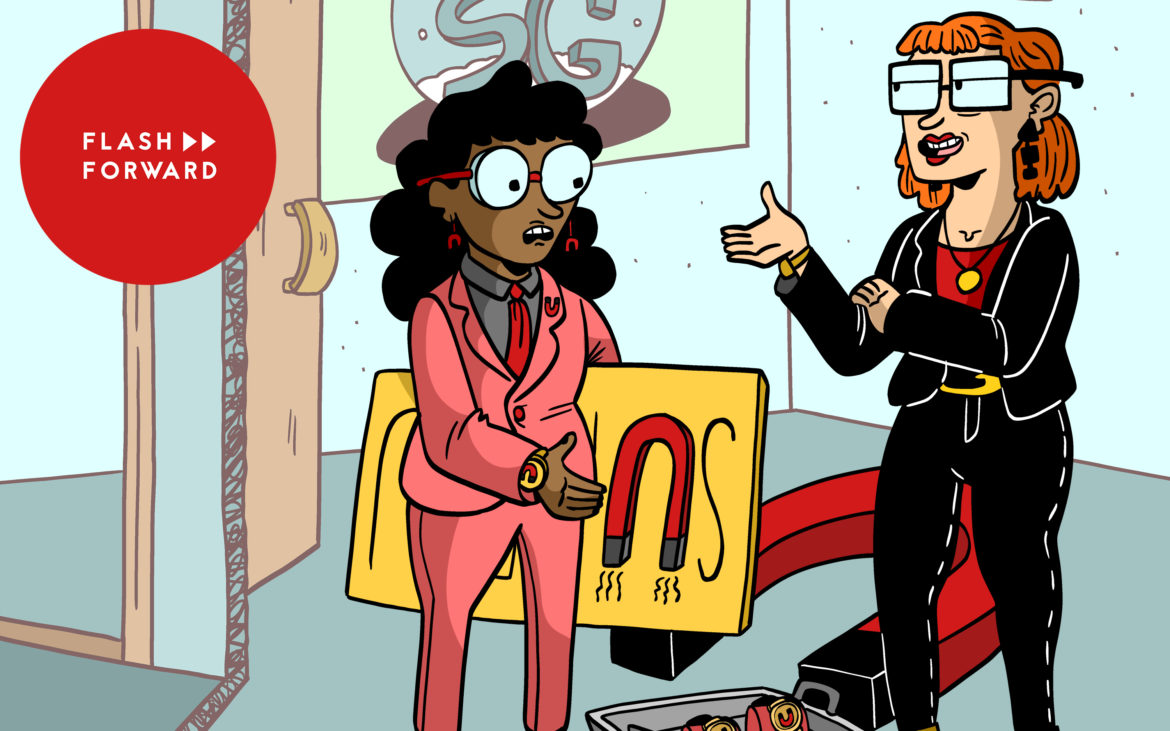

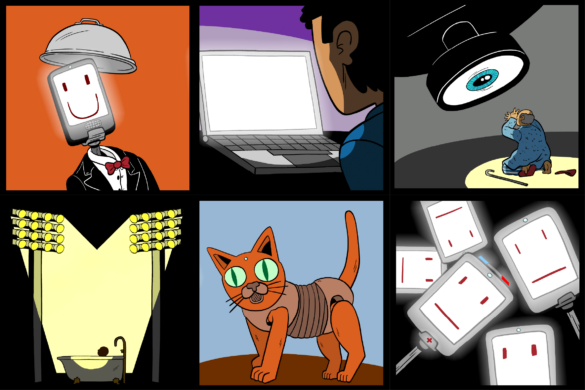
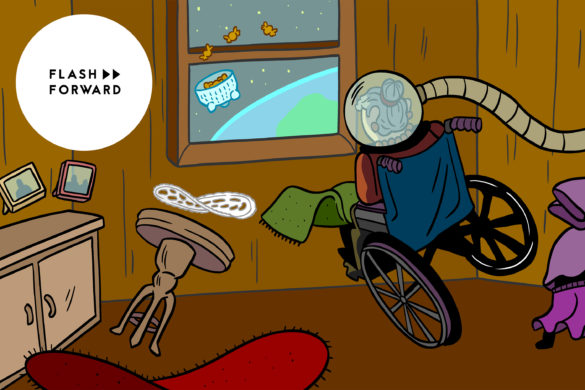


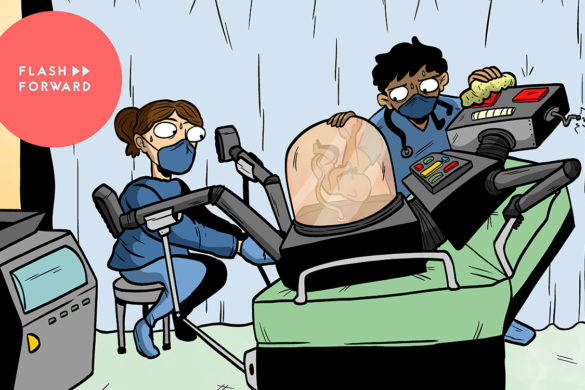
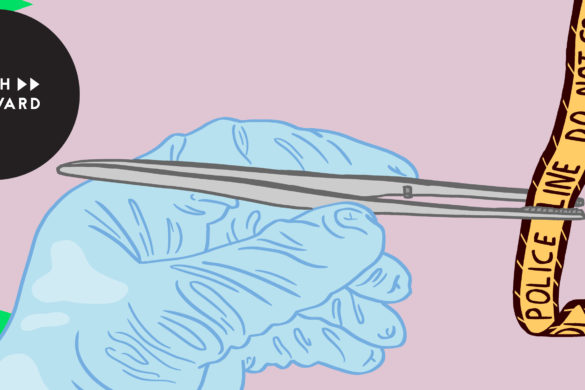
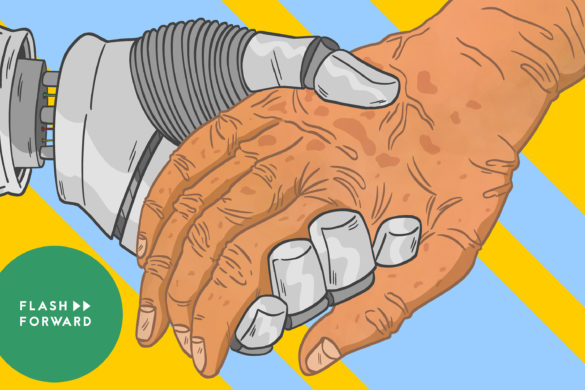
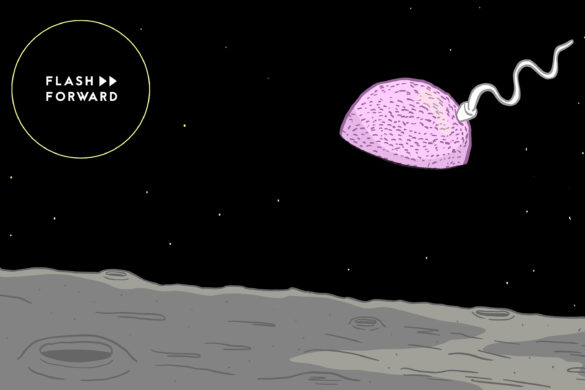
2 comments
[…] EARTH: The Polar Flip […]
I enjoyed the review of the info contained in “The Spinning Magnet” AND the humor, but if things progress as they have recently and the rate increases even more I think the humor part may end up being inappropriate–or maybe just tasteless. Pretty hard to know where we go from here, isn’t it?